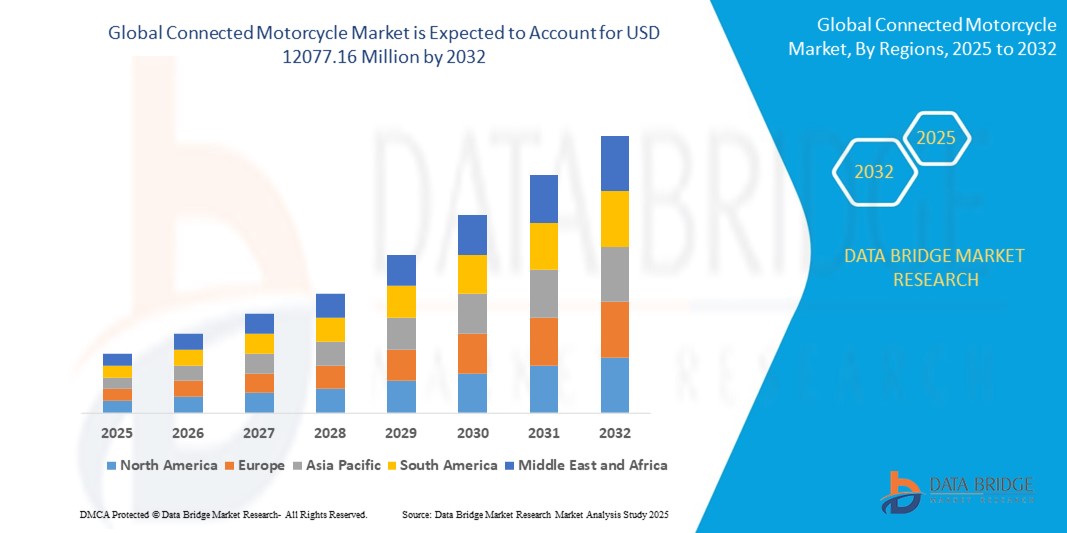1. INTRODUCTION
1.1 OBJECTIVES OF THE STUDY
1.2 MARKET DEFINITION
1.3 OVERVIEW OF GLOBAL CONNECTED MOTORCYCLE MARKET
1.4 CURRENCY AND PRICING
1.5 LIMITATION
1.6 MARKETS COVERED
2. MARKET SEGMENTATION
2.1 KEY TAKEAWAYS
2.2 ARRIVING AT THE GLOBAL CONNECTED MOTORCYCLE MARKET
2.2.1 VENDOR POSITIONING GRID
2.2.2 TECHNOLOGY LIFE LINE CURVE
2.2.3 MARKET GUIDE
2.2.4 COMPANY MARKET SHARE ANALYSIS
2.2.5 MULTIVARIATE MODELLING
2.2.6 TOP TO BOTTOM ANALYSIS
2.2.7 STANDARDS OF MEASUREMENT
2.2.8 VENDOR SHARE ANALYSIS
2.2.9 DATA POINTS FROM KEY PRIMARY INTERVIEWS
2.2.10 DATA POINTS FROM KEY SECONDARY DATABASES
2.3 GLOBAL CONNECTED MOTORCYCLE MARKET: RESEARCH SNAPSHOT
2.4 ASSUMPTIONS
3. MARKET OVERVIEW
3.1 DRIVERS
3.2 RESTRAINTS
3.3 OPPORTUNITIES
3.4 CHALLENGES
4. EXECUTIVE SUMMARY
5. PREMIUM INSIGHT
5.1 PORTERS FIVE FORCES
5.2 REGULATORY STANDARDS
5.3 TECHNOLOGICAL TRENDS
5.4 PATENT ANALYSIS
5.5 CASE STUDY
5.6 VALUE CHAIN ANALYSIS
5.7 PRICING ANALYSIS
6. GLOBAL CONNECTED MOTORCYCLE MARKET, BY MOTORCYCLE TYPE
6.1 OVERVIEW
6.2 STANDARD
6.3 CRUISER
6.4 SPORTS
6.5 TOURING
6.6 ADVENTURE
7. GLOBAL CONNECTED MOTORCYCLE MARKET, BY VEHICLE CLASS
7.1 OVERVIEW
7.2 ECONOMY CLASS
7.3 LUXURY/PREMIUM CLASS
8. GLOBAL CONNECTED MOTORCYCLE MARKET, BY RIDING TYPE
8.1 OVERVIEW
8.2 OFF-ROAD RIDING
8.3 ON-ROAD RIDING
9. GLOBAL CONNECTED MOTORCYCLE MARKET, BY COMPONENT
9.1 OVERVIEW
9.2 HARDWARE
9.2.1 EMBEDDED SENSORS
9.2.2 PROCESSORS
9.2.3 CONNECTIVITY MODULES
9.2.4 TELEMATICS UNITS
9.2.5 OTHERS
9.3 SOFTWARE
9.3.1 BY PLATFORM
9.3.1.1. APP-BASED
9.3.1.1.1. ANDROID
9.3.1.1.2. IOS
9.3.1.2. WEB-BASED
9.4 SERVICES
9.4.1 DRIVER ASSISTANCE
9.4.2 INFOTAINMENT
9.4.3 SAFETY
9.4.4 VEHICLE MANAGEMENT & TELEMATICS
10. GLOBAL CONNECTED MOTORCYCLE MARKET, BY PROPULSION TYPE
10.1 OVERVIEW
10.2 INTERNAL COMBUSTION ENGINE (ICE)
10.3 ELECTRIC ENGINE
11. GLOBAL CONNECTED MOTORCYCLE MARKET, BY CONNECTIVITY TYPE
11.1 OVERVIEW
11.2 CELLULAR
11.3 WI-FI
12. GLOBAL CONNECTED MOTORCYCLE MARKET, BY COMMUNICATION TYPE
12.1 OVERVIEW
12.2 V2V
12.3 V2I
13. GLOBAL CONNECTED MOTORCYCLE MARKET, BY NETWORK TYPE
13.1 OVERVIEW
13.2 C-V2X
13.3 DSRC
14. GLOBAL CONNECTED MOTORCYCLE MARKET, BY APPLICATION
14.1 OVERVIEW
14.2 COLLISION WARNING
14.3 EMERGENCY BRAKE LIGHT
14.4 TRAFFIC WARNING
14.5 WEATHER ADVISORY
14.6 OPTIMAL SIGNAL SPEED ADVISORY
14.7 LANE CHANGE WARNING
14.8 ROAD REPAIR WARNING
14.9 STOLEN VEHICLE TRACKING
14.10 ANTI-THEFT SYSTEMS
14.11 NAVIGATION
14.12 OTHERS
15. GLOBAL CONNECTED MOTORCYCLE MARKET, BY END USER
15.1 OVERVIEW
15.2 PRIVATE
15.3 COMMERCIAL
16. GLOBAL CONNECTED MOTORCYCLE MARKET, BY GEOGRAPHY
16.1 GLOBAL CONNECTED MOTORCYCLE MARKET, (ALL SEGMENTATION PROVIDED ABOVE IS REPRESENTED IN THIS CHAPTER BY COUNTRY)
16.1.1 NORTH AMERICA
16.1.1.1. U.S.
16.1.1.2. CANADA
16.1.1.3. MEXICO
16.1.2 EUROPE
16.1.2.1. GERMANY
16.1.2.2. FRANCE
16.1.2.3. U.K.
16.1.2.4. ITALY
16.1.2.5. SPAIN
16.1.2.6. RUSSIA
16.1.2.7. TURKEY
16.1.2.8. BELGIUM
16.1.2.9. NETHERLANDS
16.1.2.10. NORWAY
16.1.2.11. FINLAND
16.1.2.12. SWITZERLAND
16.1.2.13. DENMARK
16.1.2.14. SWEDEN
16.1.2.15. POLAND
16.1.2.16. REST OF EUROPE
16.1.3 ASIA PACIFIC
16.1.3.1. JAPAN
16.1.3.2. CHINA
16.1.3.3. SOUTH KOREA
16.1.3.4. INDIA
16.1.3.5. AUSTRALIA
16.1.3.6. NEW ZEALAND
16.1.3.7. SINGAPORE
16.1.3.8. THAILAND
16.1.3.9. MALAYSIA
16.1.3.10. INDONESIA
16.1.3.11. PHILIPPINES
16.1.3.12. TAIWAN
16.1.3.13. VIETNAM
16.1.3.14. REST OF ASIA PACIFIC
16.1.4 SOUTH AMERICA
16.1.4.1. BRAZIL
16.1.4.2. ARGENTINA
16.1.4.3. REST OF SOUTH AMERICA
16.1.5 MIDDLE EAST AND AFRICA
16.1.5.1. SOUTH AFRICA
16.1.5.2. EGYPT
16.1.5.3. SAUDI ARABIA
16.1.5.4. U.A.E
16.1.5.5. OMAN
16.1.5.6. BAHRAIN
16.1.5.7. ISRAEL
16.1.5.8. KUWAIT
16.1.5.9. QATAR
16.1.5.10. REST OF MIDDLE EAST AND AFRICA
16.1.6 KEY PRIMARY INSIGHTS: BY MAJOR COUNTRIES
17. GLOBAL CONNECTED MOTORCYCLE MARKET,COMPANY LANDSCAPE
17.1 COMPANY SHARE ANALYSIS: GLOBAL
17.2 COMPANY SHARE ANALYSIS: NORTH AMERICA
17.3 COMPANY SHARE ANALYSIS: EUROPE
17.4 COMPANY SHARE ANALYSIS: ASIA PACIFIC
17.5 MERGERS & ACQUISITIONS
17.6 NEW PRODUCT DEVELOPMENT AND APPROVALS
17.7 EXPANSIONS
17.8 REGULATORY CHANGES
17.9 PARTNERSHIP AND OTHER STRATEGIC DEVELOPMENTS
18. GLOBAL CONNECTED MOTORCYCLE MARKET, SWOT & DBMR ANALYSIS
19. GLOBAL CONNECTED MOTORCYCLE MARKET, COMPANY PROFILE
19.1 YAMAHA MOTOR CO., LTD.
19.1.1 COMPANY SNAPSHOT
19.1.2 REVENUE ANALYSIS
19.1.3 GEOGRAPHIC PRESENCE
19.1.4 PRODUCT PORTFOLIO
19.1.5 RECENT DEVELOPMENT
19.2 ROBERT BOSCH GMBH
19.2.1 COMPANY SNAPSHOT
19.2.2 REVENUE ANALYSIS
19.2.3 GEOGRAPHIC PRESENCE
19.2.4 PRODUCT PORTFOLIO
19.2.5 RECENT DEVELOPMENT
19.3 BAYERISCHE MOTOREN WERKE AG
19.3.1 COMPANY SNAPSHOT
19.3.2 REVENUE ANALYSIS
19.3.3 GEOGRAPHIC PRESENCE
19.3.4 PRODUCT PORTFOLIO
19.3.5 RECENT DEVELOPMENT
19.4 CONTINENTAL AG
19.4.1 COMPANY SNAPSHOT
19.4.2 REVENUE ANALYSIS
19.4.3 GEOGRAPHIC PRESENCE
19.4.4 PRODUCT PORTFOLIO
19.4.5 RECENT DEVELOPMENT
19.5 SIEMENS
19.5.1 COMPANY SNAPSHOT
19.5.2 REVENUE ANALYSIS
19.5.3 GEOGRAPHIC PRESENCE
19.5.4 PRODUCT PORTFOLIO
19.5.5 RECENT DEVELOPMENT
19.6 AUTOTALKS (ACQUIRED BY QUALCOMM)
19.6.1 COMPANY SNAPSHOT
19.6.2 REVENUE ANALYSIS
19.6.3 GEOGRAPHIC PRESENCE
19.6.4 PRODUCT PORTFOLIO
19.6.5 RECENT DEVELOPMENT
19.7 PANASONIC CORPORATION (PARTNER WITH HARLEY-DAVIDSON)
19.7.1 COMPANY SNAPSHOT
19.7.2 REVENUE ANALYSIS
19.7.3 GEOGRAPHIC PRESENCE
19.7.4 PRODUCT PORTFOLIO
19.7.5 RECENT DEVELOPMENT
19.8 KAWASAKI MOTORS, LTD.
19.8.1 COMPANY SNAPSHOT
19.8.2 REVENUE ANALYSIS
19.8.3 GEOGRAPHIC PRESENCE
19.8.4 PRODUCT PORTFOLIO
19.8.5 RECENT DEVELOPMENT
19.9 TE CONNECTIVITY
19.9.1 COMPANY SNAPSHOT
19.9.2 REVENUE ANALYSIS
19.9.3 GEOGRAPHIC PRESENCE
19.9.4 PRODUCT PORTFOLIO
19.9.5 RECENT DEVELOPMENT
19.10 KPIT
19.10.1 COMPANY SNAPSHOT
19.10.2 REVENUE ANALYSIS
19.10.3 GEOGRAPHIC PRESENCE
19.10.4 PRODUCT PORTFOLIO
19.10.5 RECENT DEVELOPMENT
19.11 AERIS
19.11.1 COMPANY SNAPSHOT
19.11.2 REVENUE ANALYSIS
19.11.3 GEOGRAPHIC PRESENCE
19.11.4 PRODUCT PORTFOLIO
19.11.5 RECENT DEVELOPMENT
19.12 ITURAN
19.12.1 COMPANY SNAPSHOT
19.12.2 REVENUE ANALYSIS
19.12.3 GEOGRAPHIC PRESENCE
19.12.4 PRODUCT PORTFOLIO
19.12.5 RECENT DEVELOPMENT
19.13 TVS MOTOR COMPANY
19.13.1 COMPANY SNAPSHOT
19.13.2 REVENUE ANALYSIS
19.13.3 GEOGRAPHIC PRESENCE
19.13.4 PRODUCT PORTFOLIO
19.13.5 RECENT DEVELOPMENT
19.14 HONDA MOTOR CO
19.14.1 COMPANY SNAPSHOT
19.14.2 REVENUE ANALYSIS
19.14.3 GEOGRAPHIC PRESENCE
19.14.4 PRODUCT PORTFOLIO
19.14.5 RECENT DEVELOPMENT
19.15 HERO MOTOR CORP
19.15.1 COMPANY SNAPSHOT
19.15.2 REVENUE ANALYSIS
19.15.3 GEOGRAPHIC PRESENCE
19.15.4 PRODUCT PORTFOLIO
19.15.5 RECENT DEVELOPMENT
19.16 LUXOFT (A PART OF DXC TECHNOLOGY)
19.16.1 COMPANY SNAPSHOT
19.16.2 REVENUE ANALYSIS
19.16.3 GEOGRAPHIC PRESENCE
19.16.4 PRODUCT PORTFOLIO
19.16.5 RECENT DEVELOPMENT
19.17 TRIUMPH MOTORCYCLES ( A PART OF BLOOR HOLDINGS LIMITED)
19.17.1 COMPANY SNAPSHOT
19.17.2 REVENUE ANALYSIS
19.17.3 GEOGRAPHIC PRESENCE
19.17.4 PRODUCT PORTFOLIO
19.17.5 RECENT DEVELOPMENT
NOTE: THE COMPANIES PROFILED IS NOT EXHAUSTIVE LIST AND IS AS PER OUR PREVIOUS CLIENT REQUIREMENT. WE PROFILE MORE THAN 100 COMPANIES IN OUR STUDY AND HENCE THE LIST OF COMPANIES CAN BE MODIFIED OR REPLACED ON REQUEST
20. CONCLUSION
21. QUESTIONNAIRE
22. RELATED REPORTS
23. ABOUT DATA BRIDGE MARKET RESEARCH
